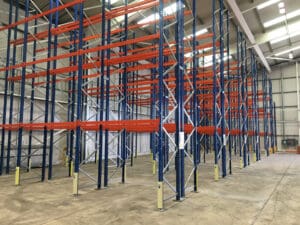
Advanced Handling & Storage Ltd
The Pallet Racking People

The short answer is: It depends. The type of pallet storage that best fits your needs is determined by a number of factors. A few of these factors include:
– How much are you willing to spend for a racking solution?
– How much floor space is available in your facility for pallet storage?
– How high are your ceilings?
– What type of pallets do you use and what are the sizes?
– How many different SKUs will be stored in the racks?
– How often do you need to access the pallets?
– Does your product have a shelf life? Do you require FIFO (first in, first out) or LIFO (last in, first out) for your product?
– How many pallets do you need to store?
– What type of fork truck will you use to access the racks? What is the lift height of these fork trucks?
Now that you better understand your requirements, let’s take a quick look at the common types of pallet storage and the advantages/disadvantages of each.
Floor Stacking
Floor stacking is the most basic method of pallet storage in which pallets are placed on the floor in rows. Depending on accessibility requirements, the rows can be as deep as available floor space allows. Pallets can also be stacked if the pallet is capable of supporting a load. This is typically a LIFO (last in, first out) system.
Advantages:
No investment in equipment
High storage density
Disadvantages:
Poor accessibility to individual pallets
Occupies a large amount of floor space
Selective Pallet Rack
Selective pallet racking is the most common type of pallet storage used today. Selective rack uses uprights and a pair of cross beams to create a “shelf” for storing a pallet. Depending on the height of your pallet and ceiling, selective rack systems typically have multiple levels (shelves) per bay. A bay is typically only one pallet deep, although two-deep systems are also a possibility.
Advantages:
Low investment compared to more dense storage solutions
Accessibility to all pallets
FIFO or LIFO
Disadvantages:
Low storage density due to aisles between rows of rack

Drive-In and Drive-Through Pallet Rack
Drive-in racking is a type of storage system that allows fork trucks to drive directly into a bay. Pallets rest on side rails rather than cross beams, which leaves the face of the bay open. The uprights are typically tied together at the top of the upright to add rigidity to the system. The only difference between drive-in and drive-through racks is whether there is an entrance at only one end (drive-in) or both ends (drive-through).
This style of rack is commonly 6-8 pallets deep per bay. Fork trucks elevate a load to the proper level and load it in the back of the system first. The second pallet will be placed in the second position from the back and continue until a lane is full. Drive-in racks are LIFO, while drive-through racks are typically FIFO. This type of system is best suited for storing a large quantity of pallets of the same product.
Advantages:
High storage density
Lower cost than a flow rack system
Disadvantages:
Poor accessibility to all pallets
Rack often gets damaged since fork trucks drive inside the system
Pallet Flow Rack System
This type of racking uses uprights and cross beams to support a gravity roller conveyor within the rack. The rollers are pitched slightly, so pallets will naturally flow toward the front of the system. When a pallet is unloaded from the front of the system, the next pallet in line moves forward to the exit position. Similar to drive-in racks, this type of system is best suited for storing a large quantity of pallets of the same product. Pallet flow rack systems are FIFO.
Advantages:
High storage density
Can be stored 20+ pallets deep
No need to drive inside the racking system
Disadvantages:
Poor accessibility to all pallets
Highest investment when compared to the other storage options

Push Back Pallet Rack
Push back racks are similar to flow rack, except the pallets are loaded and unloaded from the front of the system. The pallets can rest on either nested carts or gravity rollers. Pallets are loaded into the system by placing the inbound pallet against the pallet in the exit position and pushing it back into the lane.
Advantages:
High storage density
Only one aisle is needed for loading/unloading
Disadvantages:
Poor accessibility to all pallets
Can only be stored 4-5 lanes deep
If you find yourself in need of additional floor space, I hope these pallet storage options give you some guidance, but don’t hesitate to contact our team of experts to discuss your requirements further and find the best system for you.
Get in Touch with Advanced Handling & Storage
If you want to maximise your warehouse space through the use of second hand or new pallet racking, please don’t hesitate to get in touch with us on 0800 345 7088 or send an email to [email protected]
Make sure you follow #TeamAdvanced on Social media for all our latest news and offers!
Like us on Facebook
Follow us on Twitter
Connect with us on LinkedIn
Subscribe to Our YouTube channel
Follow us on GooglePlus
Read our other blogs on Medium
Follow us on Instagram